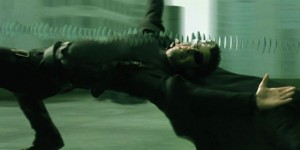OTF Reflection 3
The manipulation of time is unique only to cinema. A photographer may capture a moment and a painter may choose to artistically develop the world they see, yet time can never continue to move in these mediums. ‘The moving image’ defines cinema, as it lends itself to capturing moments, big or small, as they occur through time. Whenever the term ‘slow motion’ is mentioned, most people conjure this scene from The Matrix. This advanced expansion of time technique is referred to as bullet time, 
which according to the Isaacs was “conceived specifically for The Matrix” to show audiences they were in a constructed, unearthly space. While being some of the more memorable moments in cinema, the opening of Zombieland, the dream destruction at the cafe in Inception, the elevator of blood in The Shining to name a few, expansion of time is not just used for its ability to up the ‘wow’ factor of a shot. An example of this is the scene in American History X where Edward Norton’s character is handcuffed and taken away by police after killing an African-American man.
Shot to place the audience in Edward Furlong’s point of view, the toll this event will place on the family is placed on display. It is used to capture the range of emotions the character are going through, the rage and hate on Derek’s face as he kills a man, the anguish and shock that Danny feels is felt by viewers. Slow motion in this instance does not allow the audience to escape the horror of this event in real time, thus adding an even further layer of importance and guttural reaction the scene.
References
Kaye, Tony (1998) American History X, New Line Cinema
Wachowski, Andy & Wachowski, Lana (1999) The Matrix, Warner Bros.

Leave a Reply